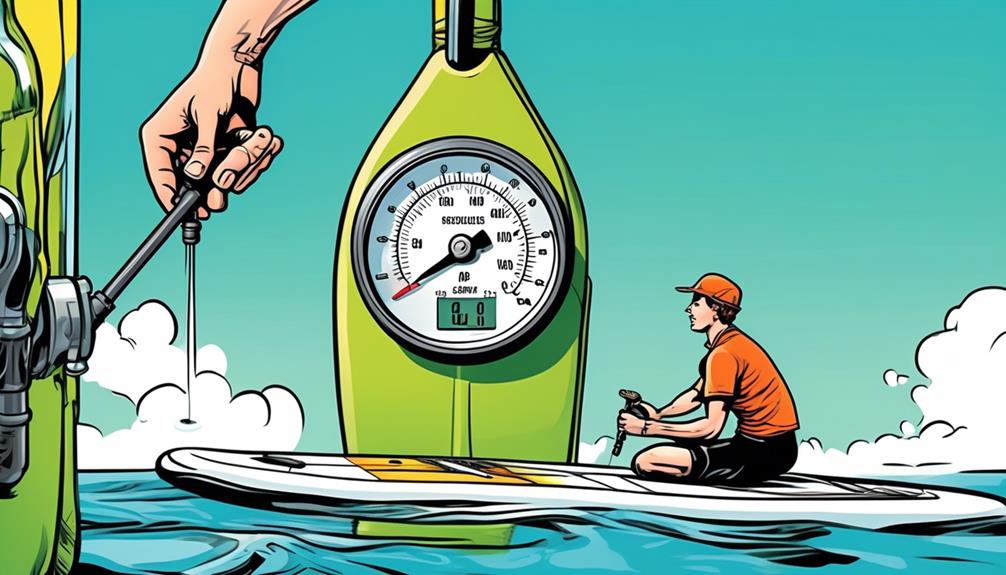Imagine setting out on a serene Alpine lake with an inflatable paddleboard that seems firm at first glance, but once you’re afloat, it begins to sag and flex, compromising your balance and the board’s responsiveness.
It’s an all-too-common scenario that underscores the importance of inflating a paddleboard to its optimal PSI. The manufacturer’s recommendation, typically between 12 to 15 PSI, serves as a benchmark, yet I’ve found that factors such as water temperature, altitude, and rider weight necessitate a more nuanced approach.
A paddleboard underinflated even by a few PSI can lead to decreased performance and increased wear, while overinflation risks damaging the board. As someone who prioritizes the longevity of my gear and the quality of my water experiences, I believe it’s critical to strike the right balance.
Join me as I explore the intricacies of PSI in inflatable paddleboards, and uncover how to fine-tune this variable to enhance your paddling sessions.
Key Takeaways
- PSI is critical for safety and optimal performance of inflatable paddleboards.
- Most inflatable paddle boards perform best at 12-15 PSI, with some high-end boards capable of reaching 18 PSI or more.
- Factors such as the paddler’s weight, water conditions, and ambient temperature affect the required PSI for rigidity and performance.
- Accurate measurement of PSI using a high-quality pressure gauge is essential for maintaining optimal glide, stability, and safety on the water.
Understanding PSI and Paddleboards

PSI, which stands for pounds per square inch, is a critical measurement for ensuring your inflatable paddle board is both safe and performs optimally on the water. As an avid paddleboarder, I understand that precision matters. Too low PSI and your board will be sluggish, difficult to steer, and may even pose a safety risk. Inflate it too much, and you risk damaging the board or causing an abrupt failure.
The sweet spot, typically between 12-15 PSI, provides the rigidity necessary for a paddle board to slice through the water with minimal flex. It’s this firmness that translates into the responsive handling and stability we crave on the water. Hitting that perfect PSI isn’t just about performance; it’s about efficiency. With the right inflation, you’ll expend less energy balancing and paddling, which means more time enjoying the glide and less time wrestling with an underperforming board.
Innovation-seekers know that the future of paddleboarding hinges on materials and designs that can maintain optimal PSI with less effort and more reliability. I’m convinced that as we push the boundaries of technology, we’ll see boards that not only self-regulate their pressure but also adapt on-the-fly to water conditions, ensuring the ideal paddling experience every time.
Ideal PSI Range for Inflatables
With the importance of precision in mind, let’s explore the ideal PSI range for inflatable paddle boards to ensure peak performance on the water. As an avid paddler and tech enthusiast, I’ve learned that hitting the sweet spot in terms of pressure isn’t just about staying afloat; it’s about optimizing your experience.
Here’s what you need to know:
- 12-15 PSI: Most inflatable paddle boards perform best within this range. It provides a firm surface for balance and efficient paddling.
- 15+ PSI: Some high-end boards can be inflated up to 18 PSI or more. This often leads to enhanced rigidity and stability, especially for heavier riders.
- 10 PSI: Considered the minimum for most adult-sized boards. Anything lower and you’ll likely experience sagging and reduced maneuverability.
- Pressure Limits: Don’t exceed the manufacturer’s recommended maximum PSI. Overinflation risks damage to your board and could void warranties.
I’m convinced that maintaining the ideal PSI range is crucial for an enjoyable and safe paddle boarding experience. It’s not about arbitrary numbers; it’s about precision engineering that aligns with the board’s design specifications. Stick to this guidance and you’ll be slicing through the water with grace and agility, all while knowing your equipment is performing exactly as it was intended to.
Factors Affecting PSI Requirements

Several factors directly influence the PSI requirements of an inflatable paddle board. These factors include the paddler’s weight, water conditions, and ambient temperature. It’s clear that a heavier rider will require a higher PSI for optimal performance to maintain rigidity and prevent the board from flexing. This isn’t just about buoyancy; it’s about the integrity of the ride. You want a board that cuts through the water, not one that bends and creates drag.
Now, let’s talk water conditions. Calm, flat waters demand less of your board, allowing for a little flexibility in PSI. However, when you’re navigating choppier waters, a fully inflated board at the upper end of the recommended PSI range offers better control and stability.
Temperature plays a subtler, yet critical role. Heat causes air to expand, potentially increasing the PSI beyond safe levels. Conversely, cold air contracts, reducing PSI and the board’s firmness. Therefore, I adjust my PSI based on the day’s forecast—higher in the morning’s cool air, cautious of overinflation in the afternoon sun.
How to Accurately Measure PSI
To ensure your paddle board maintains optimal performance, it’s crucial to consistently measure the PSI accurately using a reliable gauge. Here’s how I make sure the pressure readings are precise:
- Invest in a High-Quality Pressure Gauge: Cheap gauges can provide inconsistent results. I select a gauge known for its accuracy and durability. Opt for digital models for a more precise reading.
- Check the Gauge Calibration: Over time, gauges can lose calibration. I regularly test mine against a known standard or consider having it professionally calibrated.
- Measure at Consistent Temperatures: Temperature fluctuations affect air pressure. I always measure the PSI when the board and the surrounding environment are at similar temperatures, usually in the shade to avoid direct sunlight heating the board.
- Avoid Rushed Measurements: For accuracy, I connect the gauge firmly and give it a moment to stabilize before reading. Rushed connections can lead to false readings.
Consequences of Incorrect PSI

Incorrectly inflated paddle boards often lead to compromised performance and increased safety risks on the water. When I’m out paddling, I need my board to be at the right PSI, not just for optimal glide and stability, but also to prevent accidents that can occur from a board that’s too soft or too rigid.
If my board’s under-inflated, it’ll flex more in the water, which makes it harder to control and can cause a sluggish response during maneuvers. This isn’t just annoying; it’s a safety hazard, especially if I’m dealing with currents or winds. On the flip side, over-inflation can make the board too stiff. It might seem like a minor issue, but a board that doesn’t give when it hits waves or obstacles is more likely to cause injury, and it can even damage the board itself.
I’m convinced that keeping an eye on my paddle board’s PSI isn’t just about performance; it’s about respecting the integrity of the equipment and my own safety. By ensuring the pressure is spot on, I’m not just enjoying a better ride; I’m also promoting a culture of responsibility and safety in the paddling community.
Maintaining Optimal PSI Levels
Maintaining the optimal PSI level in my inflatable paddle board is crucial for ensuring a safe and enjoyable experience on the water. Here’s how I ensure that the PSI levels are always spot on:
- Regular Checks: I consistently check the PSI before and after each use. Even small changes in air temperature can affect the pressure.
- High-Quality Pump: I invested in a reliable pump with a precise gauge to avoid inaccuracies during inflation.
- Valve Integrity: I regularly inspect the valve to make sure it’s sealing properly and not allowing air to escape, compromising my board’s performance.
- Storage Conditions: When not in use, I store my board in a cool, shaded area to prevent the air inside from expanding and potentially causing damage due to high pressure.

